The Catskill Mountains can be wet and muddy. Having the right hiking boots can make a big difference. Additionally, the trails in the Catskill Mountains are rock-ridden. You need a good boot that is stiff enough to keep you upright without a lot of effort. There are some people who use trail runners in the summer (sneakers with rugged soles). But, with the variable terrain of the Catskill Mountains, good hiking boots work better.
Here are some of the common features you need to look for in a good hiking boot:
Thick leather
Silicon Impregnated leather to make them more waterproof
No opening in the boot until it get near the top of the boot - Look at the tongue
Good rugged soles
The sole needs to have a stiffener for 3/4 of the sole
The boots need to fit very well, like the boot was molded for your foot
The heel of the boot should not have anything that will irratate your heel
The boot should have some type of wicking material to allow your feet to breath
Cheaper boots come with thinner leather that will not hold up well, and your feet will be sore. Thick leather boots will also resist Rattlesnake bits. Thinner boots will not. The thickness of the leather should be around 2.5mm to 3.0mm. Silicon impregnated leather will keep your feet dry after a long day of walking thru streams, puddles, and mud. One of the important points of a good hiking boot is making sure it is waterproof. Look at the seams and the tongue. The tongue should be closed almost all the way up the boot. This is the number one place where water can enter your boot. To test the stiffness of a boot, take the sole in both hands and see if you can twist it. If you can, the boot is not stiff enough. The interior of the boot must have some type of material that will wick off the sweat. If not, you will develop blisters and your feet will feel hot. I normally wear winter socks all summer long.
HOW TO FIND THE CORRECT SIZE: When trying to find the correct size, you need to keep two things in mind. First, the boot should fit snuggly on the side of your foot. If the boot is too wide, you will be able to wiggle the sides of your foot. Find a narrower boot if this is the case. The sides of the boot should fit like a glove. If it is too loose, your foot will slide forward when you go downhill. This will cause blisters. Additionally, it will endanger you. Loose boots can cause you to fall. Secondly, the area by your toes should be open, and your toes should not be touching the end of the boot. Your hiking boots should fit like a downhill ski boot.
If you don't have flat feet, you should purchase sole inserts with arch support. Almost all boots and shoes are made for people with flat feet. Some boots will not support a full sole insert, so bring a 3/4 insert and a full insert when you are trying on boots. Make sure you pull out the existing insert that came with the boot. I cannot over-emphasis the importance of arch support in hiking boots. If you have an arched boot, and it is not supported, it is only a matter of time before you pull a tendon in your foot. It is called Plantar Fasciitis. It take about six months for it to heal. A $10 insert can save you a thousand dollars and six months of pain.
Make sure that you bring the socks you are going to use while hiking. You want to have all the pieces there when you try them on. Do NOT use cotton socks. One of the best hiking socks are Thorlo Hiking Socks. They are slippery to prevent blisters. They are tough to resist tearing and holes. They wick moister extremely well. They also provide excellent cushioning.
HOW TO BREAK IN NEW BOOTS: Breaking in hiking shoes is a lot different then breaking in street shoes. Hiking shoes are much stiffer then street shoes, and it takes a lot longer to make the leather conform to your feet. So, the break-in period is longer and more difficult. Boots with rubber rands (see pictures above - rubber band around the toes) will extend the break-in period. Good hiking boots, like the Scarpa boots, are made to fit your foot very well. They are made of the best materials and workmanship possible.
An old method of breaking in boots involves walking in a stream and allowing water to flow over the top of the boots. This will fill the inside of the boot with water. Then hike several miles on a hot day. This will cause the leather to conform to your feet faster. The will also cause your feet to be more abrasive against your wet socks, and can cause blisters faster. So, bring an extra pair of socks in case the pain becomes too bad. Often your boots will dry out within an hour.
Make sure that you put on FootGlide and medical adhesive tape to trouble areas. It is always better to apply tape to your trouble areas sooner rather then later. Once the blister develops, the tape will only slow down the damage. If you apply it as soon as possible, you can prevent a blister from forming.
HOW TO PERFORM MAINTENANCE: Sno-Seal is the most common form of waterproofing and leather treatment used by hikers. It has been around for decades. It is a bees wax formula. People heat up their boots on a radiator or forced-air heater grate. They then apply the Sno-Seal to the boots. You can also apply it to a room temperature boot, and then use a hair dryer to melt the Sno-Seal so that it penatrates the leather.
RATING OF SCARPA BOOTS: After 1,000 miles of testing Scarpa boots, we are now rating them for their advantages and disadvantages. But, before doing this, we need to state that everyone one has a different foot and walking stride, so one boot may fit one person well, and not fit the next person well. Scarpa boots have boots for hikers and mountaineers (rock & ice climbing). Scarpa has boots for women and for men. They are crafted differently for each sex. They also make boots for people with D and E width feet. If you have a narrow foot, I am not sure they would work well for you. You would have to try them on, and then compare them to other boots.
The soles are like most soles today. They grip well, and last a long time. From our calculations, the soles should last for several thousand miles. My only complain is that the section before the heel does not have grips for walking over wet roots. They are slippery, just like every other boot we have tested. Since Scarpa does not make the soles, they do not have control over this feature.
The leather is thicker then any other hiking boot we tested. The thickness of the leather was from 2.4mm to 3.0mm. this is very thick. It is reported that it can withstand a rattlesnake bit. Cheaper hiking boots will not stop a rattlesnake bit. We really like that the leather is silicon impregnated. This keep the boots waterproof for almost 1,000 miles. We used Sno-Seal beeswax sealer on it. Next time, we would use the special formula for silicon impregnated boots. We think this would work better. We also found that the toes did not collapse over time. They stayed round, and the original shape.
The tongue of the boot is very important part of a hiking boot. You want to make sure that the leather tongue is sealed from the toe up to the top of the boot. This is the most common place for water leaks into the interior of boots. On the Scarpa boots, the tongue is sealed correct.
The rubber rand was problematic. It was designed to make the boot more rugged and waterproof. But, on our model, the rand started to delaminate from the leather. Other hikers reported the same problem. The latest model has changed the rubber rand. It now runs around the boot. It appears that this will keep it from delaminating. The rubber rand also makes the boot harder to break-in. Once it is broken-in the opinions on the rubber rand becomes neutral.
On our model of Scarpa boot, the laces were flat. We had a hard time finding flat laces to fit the boots. They do exist. The newer models have round laces. The eyelets for the laces were strong and held up very well.
The Scarpa boots did a very good job hold me up when hiking on steep and uneven ground. When I stepped on a rock that would make me go off-balance, the Scarpa boots would hold me up vertically and make the foot steep stable. This is very important for a quality hiking boot. They also flexed forward easily and well. They did not impede the forward movement.
The boots come with insoles for people with flat feet. You will need to replace them with new insoles. Our opinion about the Scarpa insoles is that they suck. We wanted to replace them with full length insoles, but we found that there was not enough room in the toes to do this. We probably did not size the boot correctly to my foot, so this might have been the problem. Instead, we replaced the insoles with a 3/4 length insoles.
The interior was made very well. There was no pain in the heel. The fit of the foot was excellent. The sides of my fit were snug to the boot like they should be. The toes could use a little more room. The interior structure allowed excellent wicking. I wore thick winter socks in the heat of the summer, and my feet never got too hot. One major problem with Scarpa boots, is that they are a 1/2 size too small. So, if you have a size 11 foot, you need to buy a 11-1/2 for them to fit correctly. Quite a few people have to buy another set of boots because the first set are too small. You also need to go to the Scarpa site and look at the boot sizing chart. They use the European foot sizing. A size 45 is actually a US size 11-1/2.
The other major problem is that the US distributor does not have enough dealers for their hiking boots. So, you have to travel quite far to try a pair. They have lots of Scarpa ski boot dealers, but very few hiking boot distributors.
In my opinion, Scarpa boots are the best hiking boots around for the most people. They are hand-made in Asolo Italy.
|
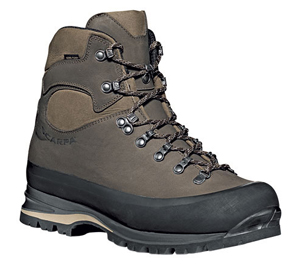 |
| Scarpa Nepal Pro GTX - New |
|
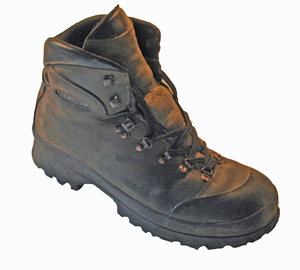 |
Scarpa Boots 1,000 miles later
Previous years model |
|
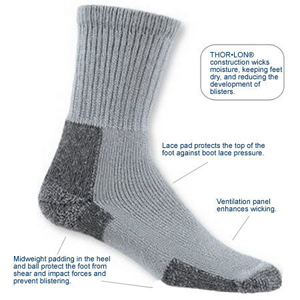 |
| Thorlo Socks (Heavy Duty - Winter) |
|
 |
| Thorlo Socks (Medium Duty - Summer) |
|
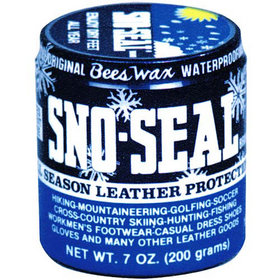 |
| Sno-Seal wax for waterproofing the leather |
|
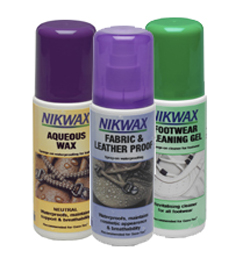 |
| Nikwax for waterproofing the leather |
|
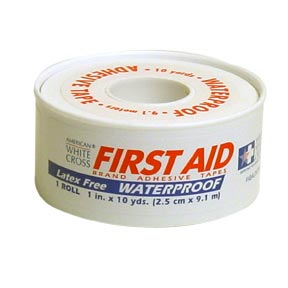 |
| Adhesive Tape for feet |
|
|

